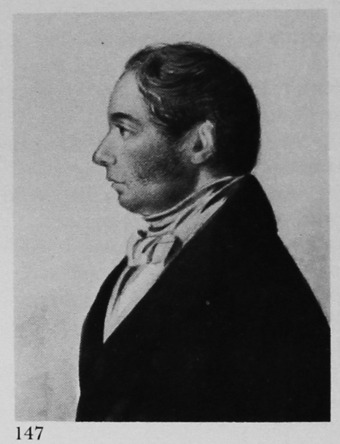Adolphe, Edgar, Monsieur (British Silhouette..., Section 6, 1978)
See Section Two for main entry
Although principally a painter of silhouettes on card, Adolphe, on his trade labels, describes himself as also a miniature painter. One extant example of a profile miniature in colour on card dates from the end of his known working life. It is almost half-length, measuring 4¾ x 2½ in., and is set in the domed centre of a much larger mount in a giltwood frame. The sitter's coat is brown; his waistcoat and de Joinville cravat are both buff-coloured. The flesh tints show a hint of Venetian red, and the hair and whiskers are painted in swirling strokes of thinned black pigment. The background is roughly painted in a wash of greenish blue and raw umber. The piece is signed 'Adolphe'; the 'e' ends in a long sweep, forming an oval about the name.
In the Fox-Smith collection there is a full-length standing figure of a man, painted in colour with the face in flesh tints. Full-length work by this artist is rarely seen, and his relative inexperience in this field is shown by this example: the sitter's legs are not rendered with the same degree of expertise as his head and shoulders, the painting of which closely resembles in style that on the half-length profile. Clothing is shown in brown, and the cane in yellow. The figure stands on a base of planked flooring, painted in squares in two alternating shades of brown, one more yellowish than the other. The card measures 12¾ x 8¾ in. Framed in maple, this example is backed with Adolphe's Trade Label No. 3, which indicates that it was painted in c. 1840. The piece is signed at the foot to the right of the flooring, 'Adolphe Brighton. '
Ill. 147

William Vasey
Profile miniature by ‘Monsieru’ Edgar Adolphe, 16 August 1846
costume dating points
This older man is not wearing his hair quite as long as that of the barber in 146.
The luxuriant whiskers, and bushy beard, typical of the 1840s.
The de Joinville cravat, with squared ends.
The typical waistcoat of the 1840s, only just sowing under the coat and of a different, plain colour.
In view of the marked V notch, and the shoulder (not gathered), the coat is probably a typical frock-coat of the period.
Author’s collection
